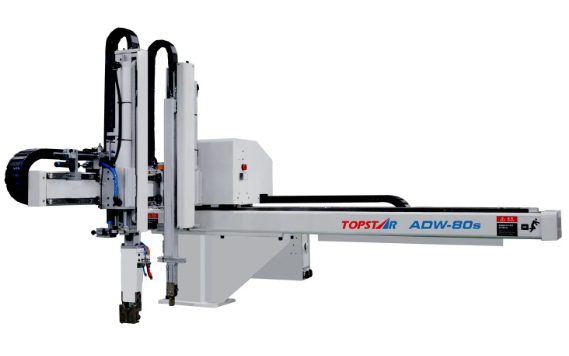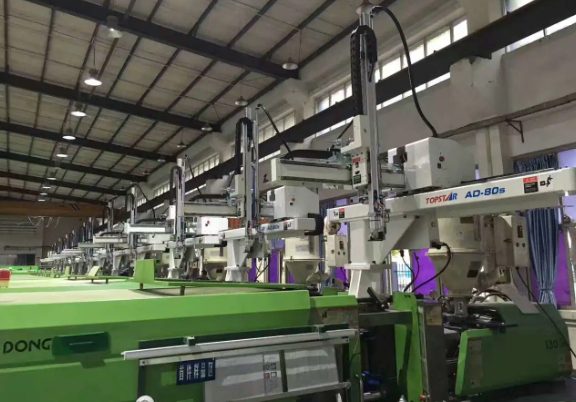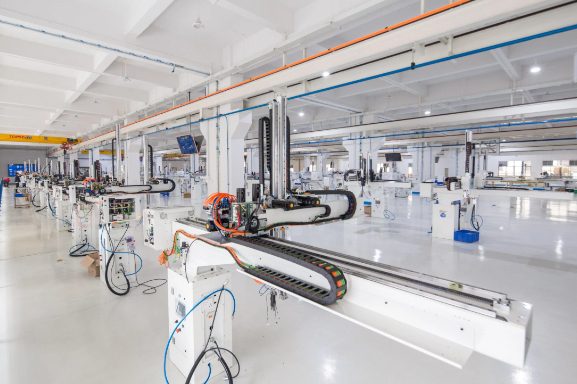Injection Molding Automation: A Comprehensive Guide to Injection Molding Robot
2024/01/04 By Topstar

In the injection molding manufacturing industry, injection molding automation has fully covered the industry and affected its overall development. In this guide, we will tell you about injection molding robot in automation and explain the critical role they play in the injection molding production process. As manufacturers everywhere increasingly adopt automation to optimize accuracy and productivity, it is essential for you, as an operator or technician, to understand the technical characteristics of injection molding robots.
The evolution of injection molding robot
In the 1950s, early injection molding machines appeared, marking the beginning of automated plastic production. Initial attempts to integrate robots into the injection molding process are rudimentary, with only basic pick-and-place functionality. In the 1970s, with the introduction of PLCs, these controllers allowed for more complex and precise control of robot motion, thereby improving the efficiency and accuracy of the injection molding process. Robots mainly perform simple tasks, such as removing molded parts from machines.
As technology moved into the 1980s and 1990s, the integration of computer CNC systems further enhanced the capabilities of injection molding robots. Introducing an articulated robotic arm with multiple axes of motion provides greater flexibility for handling complex tasks and increases the overall efficiency of the production line. The 21st century has ushered in a new era of intelligent manufacturing, and injection molding robots have continued to develop. Integrating sensors, vision systems, and artificial intelligence enables robots to adapt to changing production requirements.
Key components and features of injection molding robot
End-of-arm tools are robotic hands designed to handle tasks such as grabbing, removing, and placing molded parts. Articulated Robot Arm: This arm provides the robot with multi-axis motion, allowing it to reach various locations within the injection molding machine. Their control systems are usually based on PLC or CNC systems, which are the brains of injection molding robots. It coordinates movements, manages tasks, and ensures precise control of the robotic arm and EOAT.
Injection molding robots equipped with sensors and vision systems are usually intelligent. Sensors can detect the presence of parts, monitor the production process, and ensure quality control. Vision systems enable robots to identify and process parts accurately. The display control interface allows the operator to program and control the robot’s movements. It simplifies the setup process and makes the robot more straightforward to integrate into different injection molding applications. The ability of injection molding robots to adapt to other molds, part geometries, and production requirements is crucial.

Benefits of Implementing Injection Molding Robot
Using injection molding robots to automate the process reduces the need for manual labor, thereby saving related economic costs and improving efficiency. When faced with dangerous and challenging working environments, injection molding robots can easily handle these tasks and reduce the risk of injury. They can be easily reprogrammed and adapted to molds, part geometries, and production requirements. This flexibility allows manufacturers to respond quickly to changing market demands. Integrating sensors and vision systems into injection molding robotic systems enhances quality control by detecting defects and ensuring consistent part quality. This reduces the likelihood of defective products entering the market.
How to choose the right injection molding robot for you?
The right injection molding robot requires consideration of various factors to ensure optimal performance and efficiency in your specific manufacturing environment. The weight of molded parts and tooling must be considered to ensure the robot’s payload capacity meets or exceeds requirements. The second is to consider the range and reach of the robot to ensure it can access all areas of the injection molding machine and handle different mold configurations. Then, it’s a matter of choosing an injection molding robot that can run at the necessary speed to meet production needs based on the cycle time required for your production process. Manufacturers can customize EOAT by tailoring it to the specific tasks the robot needs to perform.娜 Proper EOAT design is essential for efficient and accurate processing of formed parts.

Technological innovation
Injection molding robots are increasingly becoming an integral part of intelligent manufacturing systems. Integration with Industry 4.0 principles involves real-time data exchange, predictive maintenance, and enhanced communication between robots and other production elements for seamless, adaptive, and data-driven operations. Innovations expected in tool-changing systems will enable injection molding robots to switch between molds quickly. This enhances production flexibility, allowing manufacturers to respond promptly to changing product demand without lengthy downtime. Vision systems in injection molding robots are expected to develop further, enabling more precise part handling. This helps improve accuracy and reduce error rates.
At the end
Injection molding robots have transformed from a mere technology into an indispensable production helper in modern manufacturing. Their role in streamlining processes, improving efficiency, and improving overall quality is undeniable. Injection molding manufacturers who adopt automation can significantly enhance their productivity and achieve more large-scale development.
TRENDING POSTS
- TOPSTAR Global Open Day 2025: Humanoid Robot Debuts, Pioneering a New Decade of Intelligent Manufacturing 2024/01/04
- Topstar Showcases TE II Electric Injection Molding Machines at InterPlas Thailand 2025 2024/01/04
- Topstar Expands Its Ecosystem Partnerships to Drive Smart Manufacturing Innovation 2024/01/04
- What factors can cause delays in the injection molding process of plastic molding machine? 2024/01/04
HOT TOPIC
- .ervo motor-driven linear robots
- •
- 1.0 guangdong topstar technology co. ltd
- 1.0 topstar china
- 1.0 topstar robot
- 11
- 160℃ mold temperature controller
- 170 ton injection molding machine
- 2
- 21
- 220-ton injection molding machine
- 23
- 260 ton injection molding machine
- 3 axis robot
- 3 axis robots
- 3 in 1 Compact Dehumidifying Dryer
- 3-axis robot
- 3-axis robots
- 39
- 41
- 460T injection molding machine
- 5-axis CNC machine
- 62
- 90 ton injection molding machine
- accuracy
- Air Chillers
- all electric injection molding machine
- all electric injection molding machines
- all-electric injection molding machine
- All-electric injection molding machines
- and overall production quality. Therefore
- AP-RubberPlas
- automated injection molding machine
- Automation changed engineering
- automation of injection molding robots
- automotive parts injection molding
- auxiliary machine
- Bench Injection Molding Machine
- Cabinet dryer manufacturers
- Cabinet dryers
- chiller
- CNC Drilling Machine
- CNC Drilling Machines
- cnc engraving machine manufacturer
- cnc laser cutting machine manufacturer
- CNC machine
- CNC Machine Center
- CNC Machine for Sale
- CNC Machine Manufacturing
- CNC Machine Tool
- CNC machine tool product
- CNC Machining Center
- CNC wood carving machine
- Cooling system
- Cross-Walking Single Axis Servo Cylinder Robot
- Cross-Walking Single-Axis Servo Cylinder Robot
- Cross-Walking Three-Axis/Five-Axis Servo Driven Robot
- cross-walking three-axis/five-axis servo-driven robot
- Dehumidifier Dryer
- Dehumidifying Dryer
- delta parallel robot
- Desktop Injection Molding Machine
- Desktop injection molding machines
- Desktop Molding Machine
- desktop plastic injection machine
- Desktop Plastic Injection Molding Machine
- Digital Transformation
- direct clamp injection molding machine
- Direct clamp injection molding machines
- Dosing & mixing system
- Drilling Centers
- Drying and dehumidification system
- drying and dehumidifying equipment
- Drying and Dehumidifying System
- drying system
- effective and efficient. Cabinet dryers are also used in other industries where large quantities of material need to be dried
- efficient injection molding machine
- elbow hydraulic injection molding machines
- electric injection molding machine
- electric injection molding machines
- energy-efficient injection molding robot
- energy-efficient water chiller
- energy-efficient water chillers
- energy-saving injection molding machine
- etc. Among injection molding robots
- exhibition
- features of CNC machine
- Feeding And Conveying System
- Five Axis Machine Center
- Flexible Production Line
- Fully automatic injection molding machine
- Gathering Topstar
- giant injection molding machine
- GMU-600 5-Axis Machining Center
- Granulating & Recycling System
- Heavy duty injection molding machine
- High-precision electric molding machines
- high-precision plastic molding machines
- high-speed all electric injection molding machine
- high-speed electric injection molding machine
- High-Speed Packaging Injection Molding
- Honeycomb rotor dehumidifier
- horizontal injection molding machine
- Horizontal Injection Molding Machines
- Horizontal Injection Moulding Machine
- Horizontal Mixer manufacturer
- How The CNC Machine Works
- hybrid injection molding machine
- hydraulic injection molding machine
- Hydraulic Injection Molding Machines
- in this article
- Industrial AI
- Industrial Automation
- Industrial robot
- Industrial Robot Chinese brand
- industrial robot parts
- industrial robot supplier
- Industrial robots
- Industry Chain
- Injection Manipulator
- injection manipulator robot
- injection mold machines
- Injection molding
- Injection molding automation
- Injection Molding Automation Solution
- injection molding dryer
- Injection molding equipment
- injection molding hopper dryer
- Injection molding machine
- injection molding machine brand
- Injection Molding Machine Factory
- Injection Molding Machine Manufacture
- Injection molding machine manufacturer
- injection molding machine manufacturers
- Injection molding machine procurement
- injection molding machine robotic arm
- injection molding machine with a robot
- Injection molding machines
- injection molding material dehumidifying
- injection molding plant
- injection molding process
- Injection Molding Robot
- injection molding robot arm
- Injection molding robot automation
- Injection molding robotic arm
- injection molding robots
- Injection moulding machine
- injection moulding machines
- Injection Moulding Robots
- Injection Robot
- Injection robot arm
- Injection robot manufacturer
- Injection robot wholesale
- injection robots
- Intelligent Factory
- intelligent injection molding machines
- Intelligent Manufacturing
- intelligent mold temperature
- intelligent mold temperature controller
- Intelligent mould temperature controller
- InterPlas Thailand 2025
- Introducing Injection Robot
- It is the best choice for drying large quantities of material at once. Cabinetmakers use these machines because they are fast
- Large flow water type mold temperature controller
- large injection molding machine
- large injection molding machines
- Learn what industrial automation and robotics is
- linear robot
- linear robots
- low speed sound-proof granulator
- machine plastic molding
- make sure to add some! Improvements (2) Keyphrase in introduction: Your keyphrase or its synonyms appear in the first paragraph of the copy
- manipulator machine
- manufacturing
- Manufacturing Innovation
- medical grade injection molding machines
- Medical Injection Molding
- medical injection molding machine
- medical injection molding machines
- micro injection molding machine
- middle speed granulator
- Mini CNC machine manufacturers.
- mobile cover making machine
- Mold Temperature Control System
- mold temperature controller
- mold temperature controllers
- molding machine
- molding material Dehumidifying System
- mould temperature control system
- mould temperature controller
- mould temperature controllers
- New electric injection molding machine
- nitrogen dryer manufacturer
- nitrogen dryer system manufacturer
- Oil type mold temperature controller
- Oil type mold temperature controllers
- open day
- optical component injection molding
- Outbound links: No outbound links appear in this page. Add some! Images: No images appear on this page. Add some! Internal links: No internal links appear in this page
- packaging injection molding
- Packaging Solutions
- PET Preform injection molding
- phone case maker machine
- phone case making machine
- phone cover making machine
- PID Control Mold Temperature Controller
- plastic bottle making machine
- plastic bottle manufacturing
- plastic bucket making machine
- plastic bucket manufacturing
- Plastic chair making machine
- plastic forming equipment
- plastic hopper dryer
- plastic injection machine
- plastic injection machines
- plastic injection molding
- Plastic injection molding equipment
- Plastic injection molding machine
- Plastic Injection Molding Machines
- plastic injection moulding machine
- plastic injection moulding machines
- plastic injection robot
- plastic molding
- Plastic Molding Industry
- Plastic Molding machine
- plastic molding machine 1
- Plastic Molding Machines
- plastic molding press
- plastic moulding machine
- plastic phone case making machine
- plastic-molding machine
- powerful granulator
- Powerful Type Sound-Proof Granulator
- precision injection molding
- precision injection molding machines
- production of plastic seats
- pure water mould temperature controller
- Robot injection molding
- robot injection molding machine
- robot manufacturing companies
- Robotic arm for injection molding machine
- robotic injection molding machines
- robotics in injection molding
- SCARA robot
- SCARA robots
- Service-oriented manufacturing
- Servo Cylinder Robot
- servo driven robot
- Servo Driven Robots
- servo injection molding machine
- servo injection robots
- servo motor-driven linear robots
- servo-driven 3-axis robot
- Servo-driven injection molding machine
- Servo-Driven Robot
- Setup of injection machine
- Silicone Injection Molding Machine
- six-axis industrial robot
- Smart Manufacturing
- Stainless Hopper Dryer
- Stainless Hopper Dryers
- star club
- swing arm robot
- take-out robot
- take-out robots
- Thailand 4.0
- the choice between servo-driven robots and hydraulic robots will have a certain impact on efficiency
- the most popular injection molding machine
- the type of injection molding robot
- TIC2000 Control System
- TMII injection molding machine
- toggle clamp injection molding machine
- Toggle Hydraulic Injection Molding Machines
- toggle injection molding machine
- Top 10 brands of injection robots
- Topstar
- Topstar Electric Injection Molding Machine InterPlas Thailand 2025 Smart Manufacturing Thailand 4.0
- Topstar Engineering
- Topstar Industrial Robots
- Topstar injection molding intelligent
- Topstar Scara Robots
- Useful Injection molding machine
- Vertical machining centers
- volumetric type blender
- water chiller
- water chillers
- water distributor
- water type mold temperature controller
- Water Type MoldTemperature Controller
- Water-Type Mould Temperature Controllers
- We often face choices when performing injection molding. We will choose the type of injection molding machine
- wholesale of injection molding machines
- x carve CNC
- 热门查询 点击次数 展示 排名 topstar
